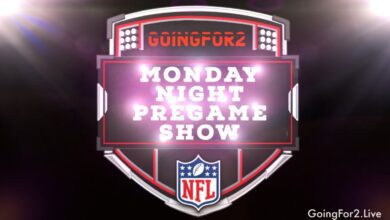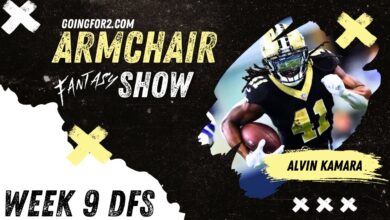Fantasy Football: Draft Dos and Don’ts Part 3
This is the third and final installment of my 2016 fantasy football draft strategy dos and don’ts. Be sure to check out Part 1 and Part 2.
In this installment, I’ll concentrate more on the strategies leading up to the draft to better prepare you for what might happen during your draft day. There is nothing worse than going into a draft expecting to draft “Player A” with your first overall pick, only to have him go one spot before you, then you’re left panicking in your two-minute draft window to find an alternative player.
Chances are that alternative player isn’t the player you would have chosen had you prepared for such a scenario pre-draft. The last three rules on my list are not mandatory rules like some of the others I have pointed out, but they are important nonetheless and could be the difference between winning or losing.
Do: Mock, Mock, and Mock some more
Mock drafts are everywhere. Every fantasy football magazine has one. Every fantasy football analyst has one, and every fantasy web-site will have one as well. If you’re satisfied with just reading them and thinking you know how your draft will go, then be prepared to be that panicked owner mentioned in the open.
There are tons of mock drafting applications out there. I’ve personally tried a bunch of them — some are good, but most are not. If your league is run through Yahoo! there is a built-in mock drafter that will link you up to other people to participate in a mock draft, and other fantasy sites, like ESPN.com and NFL.com, have similar applications.
These mock drafting applications are actually fairly decent, but they have a couple drawbacks:
- Some of the mock drafters in these groups don’t take it serious enough, and will draft players that go completely against the consensus, ruining it for everyone else.
- They can take forever to complete. They normally have a two-minute draft window, and some players take the entire two minutes, meaning the draft could take 30 minutes or more!
Another option is drafting through an application that uses some type of A.I. (artificial intelligence) or algorithm to draft players. I’ve tried a bunch of these, and some of them will just draft the “best available” option every time, and will not give you enough “what if” scenarios. Sometimes it will draft too many QBs because that was the “best available” option.

I can hear your question now, “So what do we use then?”
When I first wrote these Dos and Don’ts I was writing for another publication, and I talked up FantasyPros.com‘s mock draft tool. Little did I know that exactly one year later I myself would be writing for FantasyPros and be one of their expert rankers. I now have their mock draft tool embedded into Goingfor2.com. You can check is out by clicking here: Mock Draft Tool. If you have never heard of or used their mock draft tool, I’ll let an excerpt from their FAQ explain how it works:
FantasyPros has the largest database of expert rankings and ADP data on the web. We randomly select these cheat sheets as your opponents in the draft. You can even decide to draft against only ADP sources, Experts or specific Pre-Draft Rankings. It’s important to note that we don’t simply grab the top available player on the opponent’s cheat sheet (if you see a team drafting four quarterbacks, please contact us!). Instead, we use a pick algorithm that factors in player rankings, team needs, and position scarcity. We do this to create realistic draft results.
It not only eliminates the “mock drafting trollers” as I like to call them, but you can do a complete mock draft in a matter of minutes. The free edition has a few customizable options like choosing between standard scoring or PPR, and premium members have a ton advanced of options. I used this tool years before I created GoingFor2 and have told anyone that would listen how great a tool it is.
Now that I’ve told you where to mock draft, I’ll cover how to mock draft.
Love our content? Check out the GoingFor2 Live Podcast Network!
If your leagues are like mine, then you already know your draft position before your actual draft. That makes mock drafting a bit easier, as you can simply select the correct draft position you would like to draft from and start the wizard. Now if your league does a randomizer on the day of the draft, then you’ll need to run a few mock drafts from different positions to get an idea of how things might go.
In either scenario, the most important thing is to not do the same thing every time. Try drafting a wide receiver in round one the first time, then try drafting a quarterback in the first round on your second mock. Each time you mock, compare it to your previous mock drafts (FantasyPros will save your past mocks). This will prepare you for any scenario and help you develop a strategy for your own draft.
Obviously, your real draft will not follow your mock drafts exactly, but it gives you a better idea as to who will be available, and when.
For example, you are selecting third overall and you draft Le’Veon Bell. If you had some pre-draft illusion that you would somehow get DeAndre Hopkins in the second round, you would learn very quickly that Nuk will not be on the board at the end of the second round.
That may be a bit of an extreme example, but it’s those types of scenarios that mock drafting will prepare you for.. It will give you an idea of who might be available in every round or your draft — and that brings me to my next point…
Don’t: Discount the late rounds
Championships are won in the late rounds. That’s a statement I live by when it comes to any type of fantasy sport. Who you draft in the early rounds can be like choosing between the hot blonde or the hot brunette to ask out to the prom in high school, except the player you choose isn’t going to say “No”. In other words, it all comes down to personal preference and you can’t go wrong either way.
Successful drafting in the late rounds is where research really pays off. I have a couple real life examples I could point to, but I’ll just mention the one that really stands out.
Way back in 2005, the Pittsburgh Steelers had two pretty good running backs — Duce Staley and Jerome Bettis — so when I drafted an unknown running back by the name of Willie Parker, another owner in my league said, “That was a waste of a pick, he is a third string running back.” As karma would have it, I played that same owner in Week 1. Of course, I started Parker, and all he did was have over 200 yards from scrimmage and a TD.
How did I know Parker was going to have a breakout year? I didn’t. What I did know from reading camp reports was he was going to, at the very least, start Week 1 — and potentially longer. This was long before smartphones, there were no “RotoWorld” apps, and ESPN didn’t have entire shows dedicated to fantasy sports. In 2005 you had to dig deep for your research. I literally had every team’s website bookmarked on my computer, and would periodically check the news on each of them.
To bring this point full circle, there is tons of value to be had in the late rounds. If you put in the extra time researching those late round picks, you might find yourself a stud player. There is at least one every year, so don’t treat those late rounders like afterthoughts.
Do: Watch your bye weeks
There are two strategies when it comes to bye weeks:
- Spread them out as much as you can.
- Draft a ton of players with the same bye week.
The first strategy is the one used by most fantasy owners.The second one is a little unorthodox, with the thought being to throw away one week of the season in order to be at full strength for all the other games. Whichever strategy you decide on, it’s important to pay attention to the byes throughout the draft.
A good way to help prepare for bye weeks is by mock drafting (yet another benefit). If for example, your strategy is to spread out your bye weeks, but after your first mock draft you notice all your targeted players have byes in Week 12, you might want to rethink your strategy — or target different players.
Be careful not to over think it, bye weeks should not be the end all be all when deciding who to draft. In other words, don’t draft a lesser running back simply because he has a different bye week than your No. 1 wide receiver. The bye week should only be a deciding factor if you are trying to choose between two similarly ranked players.
There you have it, my Official Fantasy Football Draft Dos and Don’ts. I hope you have enjoyed reading them and I hope they help you in your draft this year. Sign up for our newsletter below and get all of our content delivered to your inbox.
[wysija_form id=”1″]ATTN Dynasty Commissioners: Do you want to do something cool for your league? How about a 1-hour live show dedicated to YOUR league? Team-by-team breakdowns, rankings, and more. For details and to book a show, visit: GoingFor2.com/plp.





